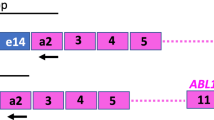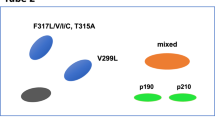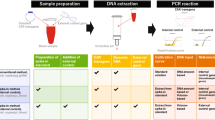Abstract
Quantitative competitive RT-PCR techniques have been developed to detect BCR-ABL fusion transcripts in CML but they are hardly reproducible. In this work, we have developed BCR-ABL quantification by real time RT-PCR using the ABI PRISM 7700 (Perkin Elmer), a new technique which allows simple and rapid quantification of a target sequence during the extension phase of PCR amplifications. A fluorogenic probe labeled with both a reporter dye at the 5′ end and a quencher-dye at the 3′ end hybridizes to the target sequence on the third exon of the ABL gene. The exonuclease activity of the Taq DNA polymerase cleaves the probe and releases the reporter dye, resulting in an increase in the fluorescence signal. The absolute copy number of the target sequence (BCR-ABL) or a control gene (ABL) in an unknown sample can then be calculated using a calibration curve prepared from a set of BCR-ABL RNA standards, and results are expressed as a BCR-ABL/ABL ratio. In our hands, the sensitivity of a serial dilution of total RNA from a positive cell line (K562) in a negative cell line (HL60) was 10−4. Fifteen CML patients in cytogenetic CR, including 11 allografted patients, two autografted patients and two patients treated by IFN were studied sequentially by this new real time quantitative RT-PCR technique in parallel with conventional qualitative two round nested RT-PCR. The two autografted patients showed high BCR-ABL/ABL ratio in all samples. The two patients treated by IFN showed a progressive decrease in the ratio. In the 11 allografted patients, four were sequentially studied 2 years or more after allo-BMT, and all ratios were below 10−4. The four patients remained in clinical and cytogenetic CR. The seven other allografted patients were studied immediately after the procedure. Three of them showed a progressive decrease in the BCR-ABL/ABL ratio which reached 10−4 7 months after allo-BMT. The three patients remained in hematologic and cytogenetic CR. The remaining four allografted patients had progressive increase of BCR-ABL ratio; three developed cytogenetic relapse 9, 11, 28 months after allo-BMT, and the last patient remained in cytogenetic CR in the bone marrow but developed granulocytic sarcoma. Results of real-time quantitative RT-PCR were in agreement with those of qualitative two round nested PCR. However, evolution changes in the results of real-time quantitative RT-PCR often preceded those of the conventional technique: a decrease of the BCR-ABL/ABL ratio preceded progression from first round to second round positivity and then negativity with the classical technique; conversely, an increase in the ratio preceded evolution with the classical technique. Thus, real-time quantitative RT-PCR may show better correlation with clinical and cytogenetic evolution than conventional qualitative techniques and may help in making early therapeutic decisions in CML, especially after molecular relapse.
This is a preview of subscription content, access via your institution
Access options
Subscribe to this journal
Receive 12 print issues and online access
$259.00 per year
only $21.58 per issue
Buy this article
- Purchase on Springer Link
- Instant access to full article PDF
Prices may be subject to local taxes which are calculated during checkout
Similar content being viewed by others
Author information
Authors and Affiliations
Rights and permissions
About this article
Cite this article
Preudhomme, C., Révillion, F., Merlat, A. et al. Detection of BCR-ABL transcripts in chronic myeloid leukemia (CML) using a ‘real time’ quantitative RT-PCR assay. Leukemia 13, 957–964 (1999). https://doi.org/10.1038/sj.leu.2401426
Received:
Accepted:
Published:
Issue Date:
DOI: https://doi.org/10.1038/sj.leu.2401426
Keywords
This article is cited by
-
Prediction of relapse by day 100 BCR-ABL quantification after allogeneic stem cell transplantation for chronic myeloid leukemia
Leukemia (2006)
-
Molecular characterization of the idiopathic hypereosinophilic syndrome (HES) in 35 French patients with normal conventional cytogenetics
Leukemia (2005)
-
BCRABL Transcript Detection by Quantitative Real-Time PCR
Molecular Diagnosis (2005)
-
Preemptive treatment of minimal residual disease post transplant in CML using real-time quantitative RT-PCR: a prospective, randomized trial
Bone Marrow Transplantation (2004)
-
BCR-ABL transcripts are early predictors for hematological relapse in chronic myeloid leukemia after hematopoietic cell transplantation with reduced intensity conditioning
Leukemia (2004)



